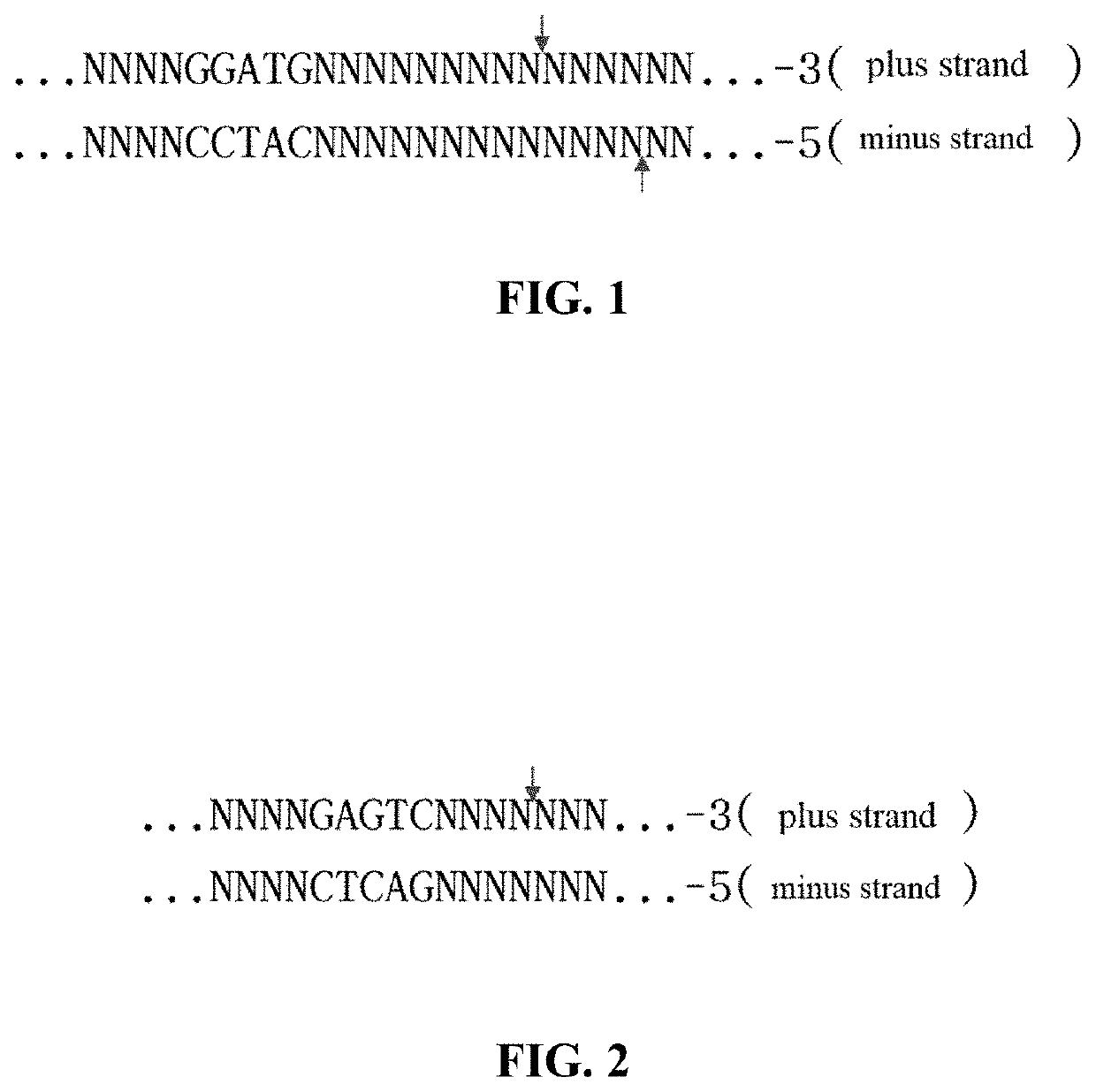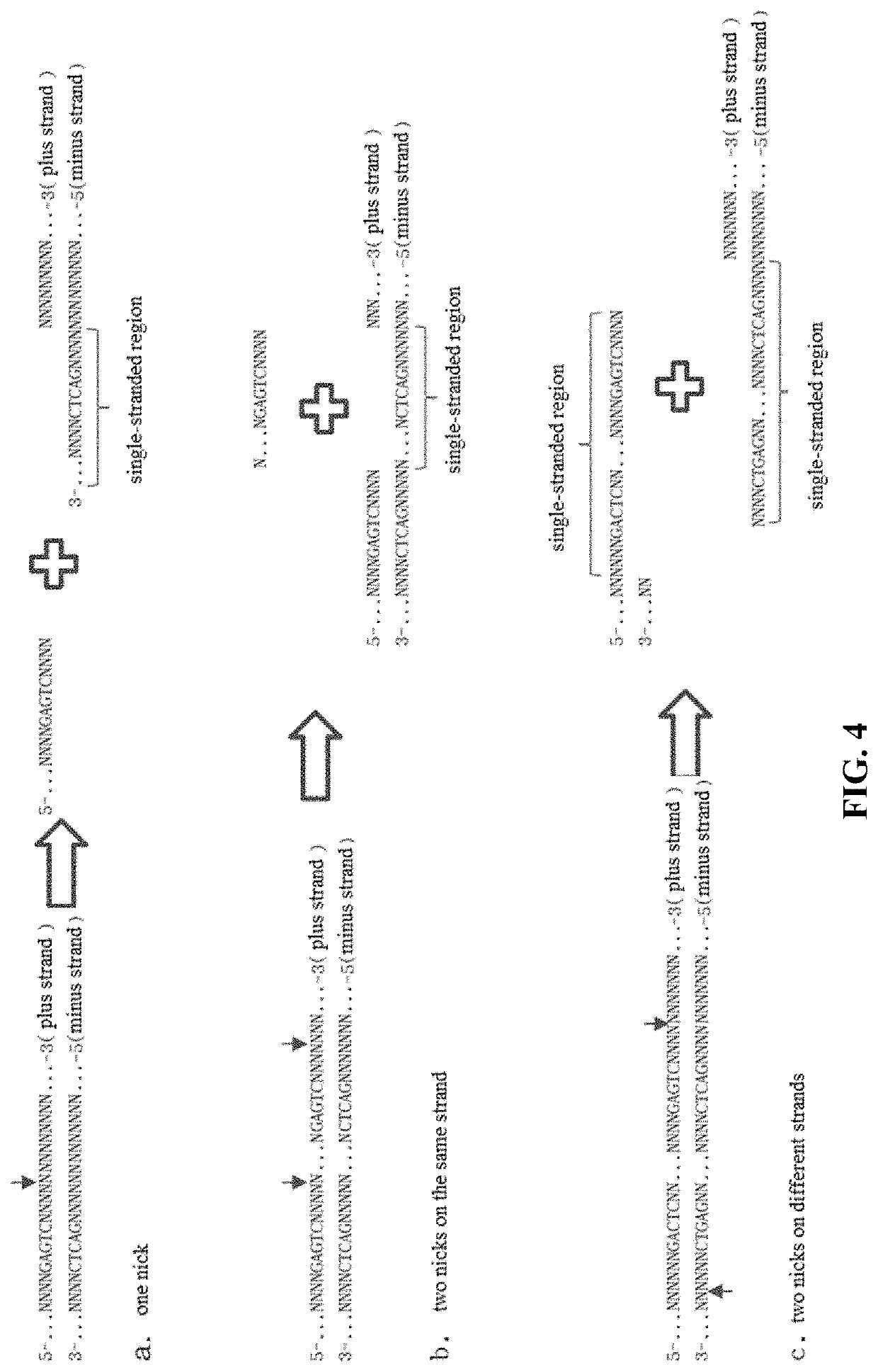Method for manipulating terminals of double stranded DNA
a technology of double stranded dna and terminals, which is applied in the field of nucleic acid modification, can solve the problems of not being able to use directly for splicing by ligase method, and cost a lot of money to do
- Summary
- Abstract
- Description
- Claims
- Application Information
AI Technical Summary
Benefits of technology
Problems solved by technology
Method used
Image
Examples
example 1
Assisted Single-Stranded Enzyme Digestion with Restriction Nicking Enzyme Nt.BstNBI
[0281]1. A target oligonucleotide S (FIG. 9b, the bases of S are underlined, including its cleaved bases) was synthesized with the sequence of
(SEQ ID NO: 1)5′-AACTCGTCTGCCTCGAGTAGTCTCCAGGATGTGGCACAGTAGCCCGTTGAATTTGGCA-3′.
[0282]2. An oligonucleotide adapter G based on the restriction nicking enzyme Nt.BstNBI (FIG. 9a, the recognition sequence of the restriction nicking enzyme has been highlighted by shading) was designed according to said inter-1 mode, consisting of an oligonucleotide forming a hairpin structure with the sequence of
(SEQ ID NO: 2)5′-CGAGGCAGACGAGGGACTCGCAAGTGCAGTTTTCTGCACTTGCGAGTCC-3′.
[0283]3. As designed, after hybridization of S and G, a cleavage occurs at the fifth and sixth bases of S (at the arrow in FIG. 9c) and a small 5-base fragment (FIGS. 9e) and 3′ end sequence of S that remained hybridized with G (FIG. 9f) are generated. The structure of FIG. 9f soon separated into two parts...
example 2
Assisted Double-Stranded Enzyme Digestion with Restriction Nicking Enzyme Nt.BstNBI to Generate a 3′ Overhang of 4 Bases
[0295]1. A double-stranded DNA sequence DS of 1104 bases in length was genetically synthesized with the following sequence.
(SEQ ID NO: 3)TGTGTGGGTAGCAACCCCTGCTACAATCAGGGCACCTGTGAGCCCACATCCGAGAACCCTTTCTACCGCTGTCTATGCCCTGCCAAATTCAACGGGCTACTGTGCCACATCCTGGACTACAGCTTCACAGGTGGCGCTGGGCGCGACATTCCCCCACCGCAGATTGAGGAGGCCTGTGAGCTGCCTGAGTGCCAGGTGGATGCAGGCAATAAGGTCTGCAACCTGCAGTGTAATAATCACGCATGTGGCTGGGATGGTGGCGACTGCTCCCTCAACTTCAATGACCCCTGGAAGAACTGCACGCAGTCTCTACAGTGCTGGAAGTATTTTAGCGACGGCCACTGTGACAGCCAGTGCAACTCGGCCGGCTGCCTCTTTGATGGCTTCGACTGCCAGCTCACCGAGGGACAGTGCAACCCCCTGTATGACCAGTACTGCAAGGACCACTTCAGTGATGGCCACTGCGACCAGGGCTGTAACAGTGCCGAATGTGAGTGGGATGGCCTAGACTGTGCTGAGCATGTACCCGAGCGGCTGGCAGCCGGCACCCTGGTGCTGGTGGTGCTGCTTCCACCCGACCAGCTACGGAACAACTCCTTCCACTTTCTGCGGGAGCTCAGCCACGTGCTGCACACCAACGTGGTCTTCAAGCGTGATGCGCAAGGCCAGCAGATGATCTTCCCGTACTATGGCCACGAGGAAGAGCTGCGCAAGCGAGTCTATACCACCGGAGTCGCATT...
example 3
Assisted Double-Stranded Enzyme Digestion with Restriction Nicking Enzyme Nt.BstNBI to Generate a 3′ Overhang of 4-Bases for Gene Splicing
[0299]1. The purpose of the example was to ligate a sequence to the pET28a (+) vector, starting with the modification of the polyclonal site of pET28a (+).
[0300](1) The sequence near the polyclonal site of pET28a (+) was >MCS
(SEQ ID NO: 5). . . GTGGTGGTGGTGGTGGTGCTCGAGTGCGGCCGCAAGCTTGTCGAAGCCATATGGCTGCCGCGCGGCAC. . .,
where the underlined part is the sequence between XhoI-NdeI on the polyclonal site.
[0301](2) The underlined part of the sequence was replaced by the following sequence, where the recognition sequence of Nt.BstNBI has been highlighted by a bolded font
(SEQ ID NO: 6)CTCGACTCTGGTGGTTGACTCTTCAAATATGTATCCGCCTGCATGCAAGCTTGAGTCATTGACCAGAGTCATG
[0302](3) The modified pET28a (+) vector was referred to as pET28aMoD, and its sequence near the polyclonal site was >newMCS
(SEQ ID NO: 7). . . GTGGTGGTGGTGGTGGTGCTCGACTCTGGTGGTTGACTCTTCAAATATGTATCCGCCTG...
PUM
| Property | Measurement | Unit |
|---|---|---|
| Temperature | aaaaa | aaaaa |
| Temperature | aaaaa | aaaaa |
| Temperature | aaaaa | aaaaa |
Abstract
Description
Claims
Application Information
 Login to View More
Login to View More - R&D
- Intellectual Property
- Life Sciences
- Materials
- Tech Scout
- Unparalleled Data Quality
- Higher Quality Content
- 60% Fewer Hallucinations
Browse by: Latest US Patents, China's latest patents, Technical Efficacy Thesaurus, Application Domain, Technology Topic, Popular Technical Reports.
© 2025 PatSnap. All rights reserved.Legal|Privacy policy|Modern Slavery Act Transparency Statement|Sitemap|About US| Contact US: help@patsnap.com



